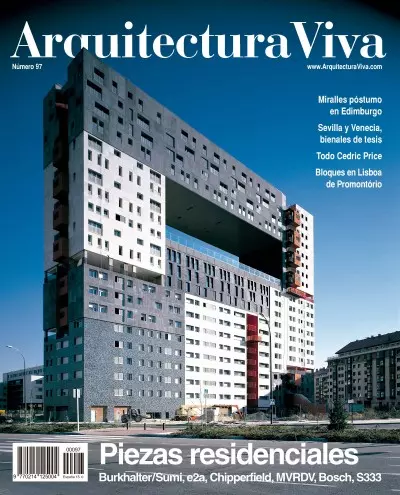Synopses
Residential Pieces. If collective housing is the raw matter of the city, the urban fragment, including built areas and public space, should be the minimal unit of the residential project. The surface of cities grows three times faster than their population; the old quarters are gradually abandoned while theres is an ongoing debate on which is the ideal density and which are the most adequate typologies to comply with sustainability criteria. Two recent examples show contemporary trends in Europe: an ecological neighborhood in Austria and the informal development of a former military area in the Netherlands.
Contents
Del Caz, Gigosos & Saravia
Neighborhoods in the Sun
Urban Models in Discussion
Juan Herreros
Social and Domestic
Common Dwelling
Justo Isasi
Solar City or ‘Collage’
Linz / Breda, Forms of Habitat
Cover Story
Swiss Neighborhoods. Close to the lake of Zurich and within a disperse environment, two examples of residential developments in small isolated units: one group of wood cubes and a condominium of concrete.
Arquitectura
Burkhalter & Sumi
Housing Complex, Ziegelwies
e2a / Wim & Piet Eckert
Housing Complex, Kilchberg
Madrid Blocks. The city’s new neighborhoods follow a conventional urban grid, with few exceptions carried out by foreign architects; if the English block stretches the regulations to the limit, the Dutch is a vertical piece.David Chipperfield
Block in Villaverde, Madrid
MVRDV & Blanca Lleó
Block in Sanchinarro, MadridDutch Density. Forced to make the most of the scarce amount of land available, Rotterdam and Groningen are the scenarios of two new projects of urban densification, in a central district and in an old industrial site.
Bosch Architects
City Building, Rotterdam
S333
CiBoGa, GroningenViews and Reviews
Violence and Aesthetics. Three museums in Barcelona and the Artium of Vitoria present war as an aesthetic phenomenon, the downfall of utopia, the ethical dimension of art and the political stances of contemporary authors.
Art / Culture
Juan Antonio Ramírez
Aesthetics and Conflict
Jaume Vidal Oliveras
Shattered Ideals
Seville-Venice, Thesis Biennials. For the first time the Andalusian city is the venue of a biennial of contemporary art, coinciding with the 9th edition of the Italian exhibition devoted to the international architecture scene.Juan Antonio Ramírez
Dreams, Joy, Weightlessness
Richard Ingersoll
The Belly of the WhaleCedric Price in Books. Two recent titles in which projects and texts are combined fill a bibliographic void and reivinicate the legacy of the British architect, who always predicted a future better than the past.
Focho’s Cartoon
Hans Kollhoff
Various Authors
Books
Recent Projects
Assemblages in Lisbon. The Portuguese studio Promontório has turned sobriety into its hallmark; in three different sites of their home city, an equal number of collective housing projects with additional space for other purposes show how standardization, prefabrication and the use of industrial materials such as fibercement are compatible with domestic programs.
Technique / Style
Kenneth Frampton
Coociclo Building
Gerrit Confurius
Oriente Complex
Nuno Grande
Carnide Block
To close, the president of the jury of the last edition of the Venice Biennale International Architecture Exhibition comments on the prizes awarded during the event. Entitled ‘Metamorph’, the official selection presents the changing forms of contemporary trends, and the polyhedric perspective of the national pavilions rounds off this mutating and dizzying landscape.Products
Light, Floors, Plasterboards
English Summary
Residential Pieces
Luis Fernández-Galiano
Venice, Lions and Chimeras
LuisFernández-Galiano
Housing without City
The problem of housing has become the problem of the city. During the 20th century, the urban mutation spawned by the mechanization of agriculture and the migration from the country to the city gave rise to the so-called ‘housing problem’. The areas where industrialization took off had been through it before, and the unhealthy overcrowding of urban masses was the backdrop for the hygienist promise of modern architecture, that fed on the same spirit of renewal and the same moral indignation as the projects of Utopian socialism or the protests of revolutionary marxism in the previous century. In the eve of the 21st, though only in the developed world, housing is no longer a quantitative or health concern, but a qualitative and environmental one: having guaranteed minimal dimensions, effective ventilation and adequate sunlight, the contemporary dwelling suffers from visual mediocrity, routinary programs and anorexic contexts.
With the only exception of the new immigrant lumpenproletariat – that inhabits city centers in conditions that resemble those described by Engels for the English working-class of the first industrial revolution –, the rest of the urban population of the prosperous West does not really face dramatic dilemmas in the field of housing. The real-estate bubble has indeed sent the young out to the most desolate peripheries, and the growing fragmentation of family groups – added to the unstoppable growth of housing for singles – multiplies the demand for smaller dwellings, but this combination of distance and size causes no other inconveniences than long commuting itineraries and a costly atomization of services; a wasteful scattered colonization of the territory that shall be reversed decisively only when forced to do so by the cost of energy, but that in the meantime shows a significant capacity of attraction for residential investment.
This formless hypertrophy of cities with ‘garbage urbanism’, to form a horizontal Babel of anonymous neighborhoods and lifeless residential developments – similar in their morphological structure to cellular metastases or bacterial cultures –, is the most important challenge for those politicians and citizens striving to design a voluntary geography that could express the genuine nature of the social body through the physical landscape. It is inevitable to think that, regardless of our own wishes, the formal decay of the contemporary city is a faithful reflection of the deterioration of the collective organism: an ailing tissue in which the singular beauty of some architectural pieces seems as pathetic as jewelry on a haggard face. Housing is not a problem that asks for aesthetic experiments or stylistic innovations; it is an urban problem, one of the civitas or the polis, that is, one of citizens and politics. We need more architecture; but, above all, we need more urbanity.








